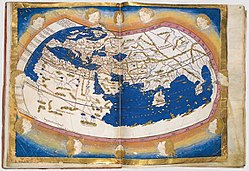Old World
This article needs additional citations for verification. (March 2013) |


The "Old World" consists of Africa, Europe, and Asia.[1] It is used in the context of, and contrast with, the New World (consisting of North and South America).[2] Some areas, such as Australia and Antarctica, are not considered part of the Old World or the New World.
Etymology
In the context of archaeology and world history, the term "Old World" includes those parts of the world which were in (indirect) cultural contact from the Bronze Age onwards, resulting in the parallel development of the early civilizations, mostly in the temperate zone between roughly the 45th and 25th parallels, in the area of the Mediterranean, Mesopotamia, Persian plateau, India and China. These regions were connected via the Silk Road trade route, and they have a pronounced Iron Age period following the Bronze Age. In cultural terms, the Iron Age was accompanied by the so-called Axial Age, referring to cultural, philosophical and religious developments eventually leading to the emergence of the historical Western (Hellenism, "classical"), Eastern (Zoroastrian and Abrahamic) and Far Eastern (Hinduism, Buddhism, Confucianism, Taoism) cultural spheres.
History
The concept of the three continents in the Old World, viz. Asia, Africa, Europe goes back to classical antiquity. Their boundaries as defined by Ptolemy and other geographers of antiquity were drawn along the Nile and Don rivers. This definition remained influential throughout the Middle Ages (see T and O map) and the Early Modern period.
Other Names
The mainland of the three continents (excluding islands such as the British Isles, Japan, Sri Lanka, Madagascar and the Malay Archipelago) has been referred to as the World Island. (The term may have been coined by Sir Halford John Mackinder in The Geographical Pivot of History.[3])
The region of the Old World corresponds to the Midgard of Germanic languages, popularized as Middle-earth in the fantasy writings of J. R. R. Tolkien.[citation needed]
See also
References
- ^ "Definition of Old World". Oxford Dictionaries. Oxford University Press. Retrieved 2 April 2013.
- ^ "New world - definition". Merriam-Webster Dictionary. Retrieved 2 April 2013.
- ^ See Francis P. Sempa, Mackinder's World











